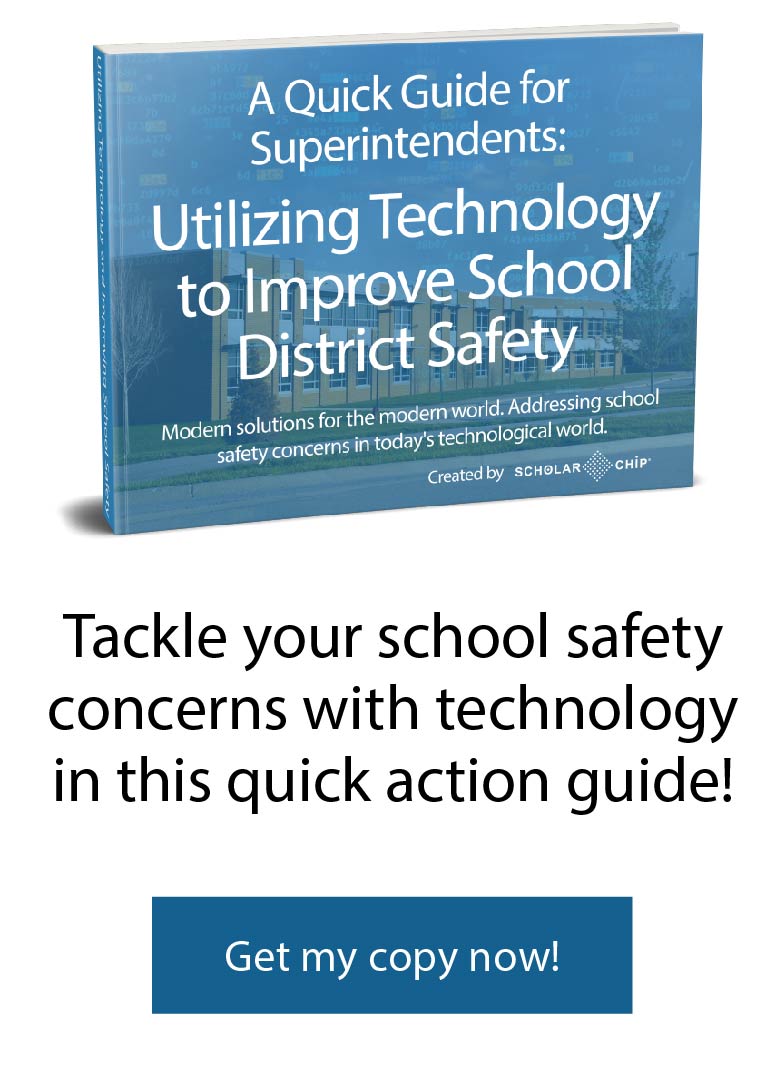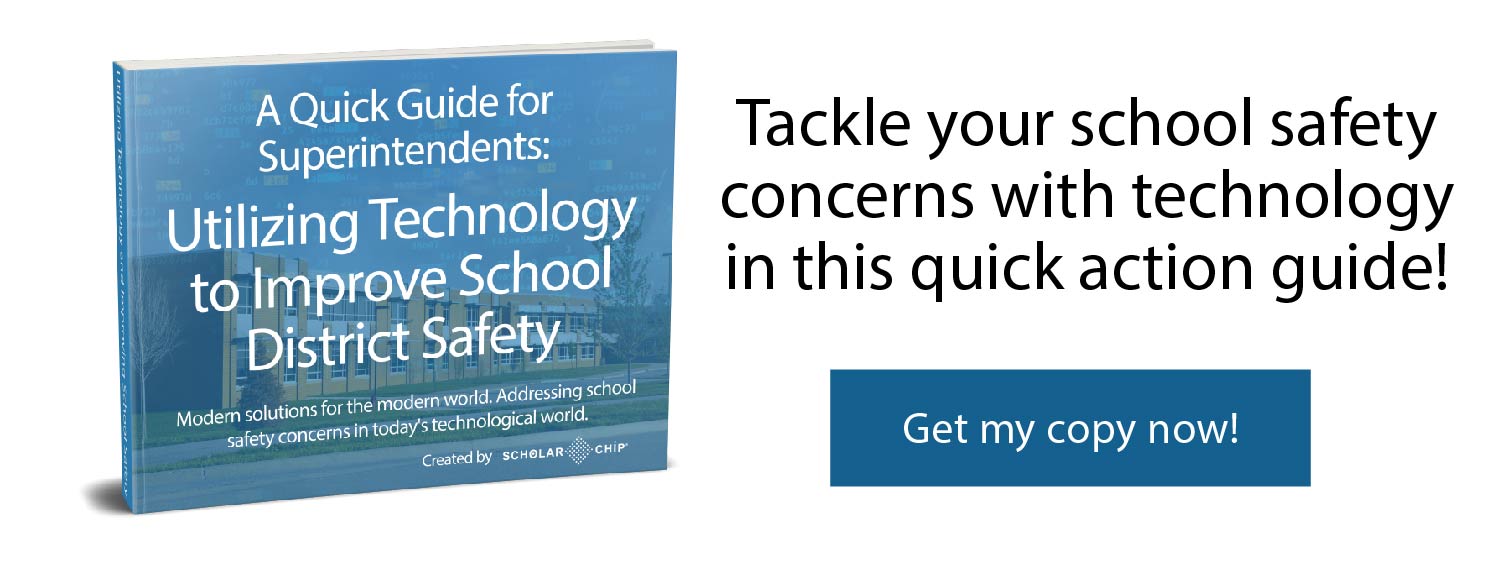The RAND Research 2016 study, Role of Technology in Improving K – 12 School Safety, cites comprehensive, annually updated school safety plans as essential to securing schools. While programs must be tailored to meet the unique needs of a district, technology is an important component of any modern plan. School leaders revisiting their district’s safety plan and investigating technologies to replace aging systems are finding cost-effective solutions with smart card benefits.
Schools are the heart of a community, and education within a school’s walls goes beyond academics. It is an entry point into society for children, often their first experience outside their insular home environment. Ideally, students experience an inclusive and caring atmosphere in their classrooms but can fall due to outside issues Chronic absenteeism is a large issue that needs to be addressed with school districts. Fortified buildings with armed guards and metal can also create an unfriendly environment for students. The challenge for school leaders and superintendents is how to create and maintain a welcoming environment while ensuring the safety of students and staff on school grounds.
Vulnerabilities of Low-Tech Solutions
Over the past 30 years, incidents of violent attacks against schools have repeatedly drawn intense media coverage. One way schools have responded is by implementing systems for monitoring who enters and exits a building. Inexpensive, low-tech solutions, such as entrance sign-in sheets and laminated name badges to identify personnel may have served well enough years ago, but are no longer adequate to meet today’s security demands. The weaknesses of these systems are apparent.
Office staff, a “greeter” at the front entrance and hall monitors, may be able to watch who enters and exits a classroom during the day. At the start of the day, the volume of students and staff moving through the doors makes it nearly impossible to identify and keep track of who is in the building at any one time. District administrators need to access information from multiple buildings in real-time from a central location to see data that is critical during a lockdown or evacuation process.
No matter where students are on campus, schools are responsible for the safety of the students, such as buses and in their buildings, yet fulfilling this responsibility is difficult when school personnel does not have accurate attendance to collect. Systems that require a teacher to manually input attendance are prone to error, and the information may not be updated routinely, for example, a student initially marked absent arrives late to class. Attendance systems that require a teacher to log-in to their computer are of no essential use when it comes to tracking students on buses, at field trips or during extra-curricular outdoor events. There are few attendance systems that help provide data that can send alerts and notifications to parents of the student that may be late or missing.
New Technology Offers Solutions with Smart Card Benefits
Smart ID cards are chip-embedded and utilize Radio Frequency Identification (RFID) technology to connect a cardholder to a dedicated system. Passive RFID cards, the type used by ScholarChip, do not send out signals and contain only an identification number. To connect with a school’s IT programs, the card must be tapped on the smart card readers provided at the entrance of a building. Lost cards may be quickly voided and do not present a security threat. This technology is an upgrade from barcodes and magnetic strips. Barcodes may be forged, and they tend to wear out fairly quickly. Magnetic strips requires longer processing time, making them a poor choice for checking in large groups of people. Both older systems lack the ability to integrate multiple functions.
Control Building Access and Keep Track of Students
A smart ID card is how an individual connects to a school’s systems. Each individual’s specific access permissions are controlled on the backend. Students may tap themselves into their classrooms in order to record attendance. They may use their cards to pay for lunch in the school cafeteria and check out books in the library as well. The rise of mobile applications make it possible to take attendance outdoors, at after-hour activities, on buses, and field trips. Keeping track of building access is one of the most important security aspects to strengthen. At times, students can attempt to access school buildings without permission, even when attempting to use their smart ID card, due to privilege access, they will not be able to depending on the time of day.
Improve School Climate
The Federal Commission on School Safety, formed in the wake of the 2018 school shooting in Parkland, Florida, reviewed decades of studies on targeted school violence to determine causes and develop recommendations. A final report, issued December 2018, found one commonality among shooters. Nearly all of them felt isolated from their schools and their peers and were often targets of bullying. This finding led the Commission to recommend schools develop a “culture of connectedness,” a sense of ownership among students, as an important step towards improving school safety.
Holding students accountable for their attendance and giving them a measure of autonomy by issuing smart ID cards can help students with a sense of ownership in their school. While teachers must continue to enforce school rules in their classrooms, relieving teachers of attendance-taking tasks is a subtle way of softening the authoritative tenor of teacher-student relationships. Student’s need to feel happy and safe and when they don’t, there becomes a domino effect of issues that could arise. Taking the extra step and implementing a school safety plan with smart technology can help increase your school climate.
Access Accurate and Timely Data
Cloud storage is the future and protects information from corruption or loss caused by physical damage to onsite servers. Powerful reporting functions streamline report creation and allow leaders to access complete data sets across attendance, SIS, behavior management and other systems for better decision making. Problem behaviors, such as chronic absenteeism of students skipping class to go to the cafeteria, are quickly exposed. In the event of an emergency, one or all doors in the building may be locked. Door permissions may be added or revoked remotely. Real-time data and visitor management data may be shared with first responders.
One proactive solutions to help create an efficient school safety plan across your district is by utilizing smart technology with smart card benefits. Scholarchip is that proactive solution that share the same goal, to create a safe and welcoming climate to promote education and success. ScholarChip is an all-in-one, platform solution to help reduce school threats and address the important issues surrounding school safety. Data from students, faculty, and stakeholders are leveraged to manage school access, attendance, and behavior management through the platform tools to increase safety and promote the campus climate schools are looking for.
If you are ready to take the next step in tackling your school safety plan with efficiency, feel free to reach out to Scholarchip today and schedule a focused 1-on-1 walkthrough!


